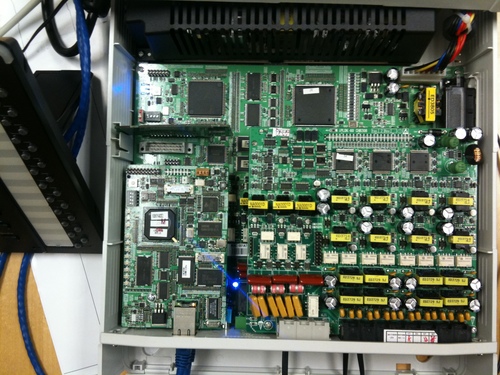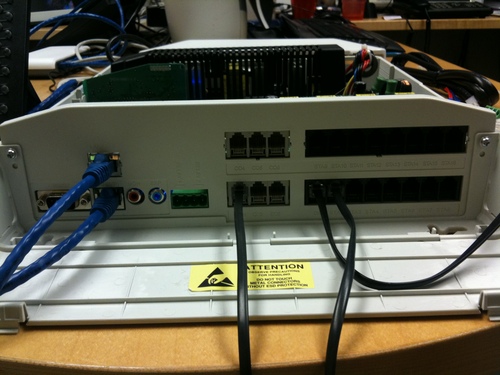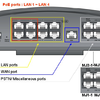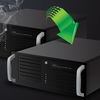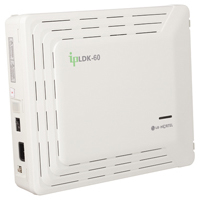 The LG-Ericsson ipLDK-60 is a flexible, feature-rich IP-PBX platform designed for SMBs, supporting up to 48 digital and analog extensions through a variety of terminals including digital, IP and analog phones, and fax machines. Calling it an IP-PBX is a bit of a misnomer since it’s more of a hybrid IP-PBX “key system”, supporting many traditional key system features that SMBs love. For instance, it supports Line Appearances, Call Park, Page and Call Pick-Up, as well as cost control capabilities such as prepaid call, barge-in, forced trunk disconnect, and LCR. The ipLDK-60 supports analog and VoIP trunks as well as IP phones and LG-Ericsson’s proprietary digital phones. They also offer their own softphone client to use with the platform.
The LG-Ericsson ipLDK-60 is a flexible, feature-rich IP-PBX platform designed for SMBs, supporting up to 48 digital and analog extensions through a variety of terminals including digital, IP and analog phones, and fax machines. Calling it an IP-PBX is a bit of a misnomer since it’s more of a hybrid IP-PBX “key system”, supporting many traditional key system features that SMBs love. For instance, it supports Line Appearances, Call Park, Page and Call Pick-Up, as well as cost control capabilities such as prepaid call, barge-in, forced trunk disconnect, and LCR. The ipLDK-60 supports analog and VoIP trunks as well as IP phones and LG-Ericsson’s proprietary digital phones. They also offer their own softphone client to use with the platform. LG-Ericsson ipLDK-60 Inside View (top cover off)
Leveraging IP Trunks, up to 72 ipLDK-60 branches can be networked together providing the ability to leverage features such as centralized attendant and voice mail, common dialing plan, transfer, follow me forward etc. The ipLDK-60 SIP Trunks enable third-party SIP products to interoperate as well.
LG-Ericsson came to TMC’s offices to demo the ipLDK-60 and have us test this product. One of the key differentiators for this product is that it is very flexible. For instance, you can use analog, PRI, or ISDN trunks. SMBs ready to transition to SIP can also use SIP trunks. The expansion modules in the ipLDK-60 are swappable and upgradeable. The configuration in the box we tested included support for 6 analog trunks and up to 16 digital phones. Here's a photo of the back panel ports:
The ipLDK-60 features your typical built-in voice mail and auto attendant for routing calls. It also supports computer applications such as TAPI PC Phone and Attendant as well as remote system access for system maintenance. Interestingly, it has support for H.323, the long forgotten VoIP standard, which is still prevalent in many conference rooms, especially H.323 videoconferencing systems. Some of the other features include Text Messaging (SMS), Caller ID name and number, 15 party conference, call recording, call coverage, and voice-over on a busy call.
One unique feature is the Voice Mail Notification which will automatically call your cell phone when there is a new voicemail. According to LG-Ericcson, “The ipLDK-60 includes several call budget control capabilities to curb your communications costs such as, call traffic monitoring and forced call control by authorized manager. Least Call Routing (LCR) is a call control feature that preselects the least expensive call routes, ensuring the lowest cost and greatest value.”
One cool feature useful in some SMBs such as legal firms is the ability to a user to temporarily override the toll restriction of a station to make toll calls from a normally toll restricted station. The user must input an Authorization Code in order to activate “Walking COS”. The Walking COS is applied after the code is entered for the next CO line call. Similarly, it supports hot desking. When an Agent logs in, the Hot Desk will become active and will take on the attributes defined for the Agent’s station number, including all the personalized button mappings. When the Agent logs off, the Hot Desk station becomes inactive and the Agent’s calls are forward to the user-entered destination. A different Agent may then login through the inactive Hot Desk station. Another cool feature is that you can open doors with special feature codes, due to its door alarm integration feature. Relatedly, you can creating paging zones with certain extensions assigned to them so you can for instance page a group of phones and say “Hey accounting department. You have a delivery at the front door”.
While they were demonstrating the system LG-Ericsson showed how you could just about configure any feature you want using special key codes on the phone itself. This certainly harkens back to the day where there was no web-based configuration tools for phone systems and phone systems used the phones themselves for configuration. So certainly LG-Ericsson kept some of their legacy roots. They do of course offer a Windows-based admin interface for easier configuration. The admin interface also has a legacy telecom feel to it. I’ve used similar user interfaces to configure other key systems and PBXs. If you’re an expert on that particular brand of phone system it’s easy to figure things out, but if you’re a newbie, it definitely has a bit of a learning curve. It’s interesting that LG-Ericsson added more recent technologies such as VoIP phones and SIP trunking support, but retained the same admin UI, as seen here:
I would have figured they would have switched over to a web-based interface. However, there is something to be said for leveraging their existing investment. Further, to ‘bolt-on’ a web interface into the underlying operating system might require an entirely new operating system, which defeats the purpose of this hybrid key telephone system to keep costs down while retaining a ton of features. The ability to centrally customize each and every phone’s button mappings was a powerful feature. Still, I wasn’t crazy about the admin UI, but I can see with a little time using it a telecom administrator can quickly configure new IP or digital phone extensions very quickly and even copy settings from phone-to-phone. Similarly, the softphone application, Phontage, has a Windows 98 look to it and could use some updating, though it is pretty functional and easy to use.

Phontage softphone application
Key Features:
- VoIP Services (SIP, H.323/H.450)
- PC Soft Phone
- Automated Call Distribution (ACD)
- Centralized Attendant Service
- QSIG and IP Networking
- Conference Room (15 parties)
- PC Admin in Maintenance
- Direct Inward Dialing / Direct Inward System Access (DID/DISA)
- Call Recording
- Mobile Extension
- Call Statistics and Traffic Analysis
- Internal SMS Text Messaging
- Hunt Groups
- Multiple Class of Service with
Walking COS - Internal / External Call Paging
- Door Phone Box
- Least Call Routing (LCR)
Comprehensive Features List:
Auto Call Number Redial• Barge In
• Call Forward
- Busy
- Busy/No Answer
- Immediate
- Off-Net
- Preset
• Call Coverage
• Call Log
• Call Park
• Call Pickup
- Directed
- Group
• Call Transfer
• Call Screening
• Camp On
• Conference
- Conference Room: up to 15 parties
- Multi-Party: up to 15 parties
• Do Not Disturb (DND):
- One Time DND
• Headset
• Hot Desk
• Hot Line/Warm Line
• Hold Preference
• Intercom Call Hold
• Intercom Mode Select
• Last Number Redial (LNR)
• Meet Me Page
• Messaging
• Mobile Phone Support
• Multi-lingual Display
• Mute
• Save Number Redial
• Speed Dial: Station (100)
• Station Serial Call
• Station Linked
• Station Message Wait/Call Back
• Voice Over
• Services
• Call & Queuing
• Forward
• Intrusion
• Override
• Positions: 5
• Recall
• Reports
• IP Address Dialing
• IP Phone Support
• IP Softphone (Phontage)
• VOIP Service: SIP H.323 / H.450
• VOIP Networking
• ISDN Qsig
• Centralized Attendant (CAS)
• Automatic Call Distribution (ACD)
• ACD Reports
• ACD Supervisor
• Account Codes
• Alarms
• Background Music
• CO Line Distinctive Ringing
• CO Line Name
• CO Line Queuing
• CO Line Preset Forward
• CO Line Step Call
• CO Line Ring Assignments
• Data Line Security
• Direct Inward Dialing (DID)
• Direct Inward System Access (DISA)
• Distinctive CO Line Ringing
• External Control Contacts
• Emergency Call Service
• ISDN Services
• Least Call Routing (LCR)
• Lost Call Printout
• Paging Internal/External
• Park and Page
• PC Programming
• PC Admin Maintenance
• Station Hunt Groups
• System Directory
• System Speed Dial (500)
• SMDR
• Tenant Service
• Tenant Groups (5)
• Traffic Analysis
• Wakeup Service
• Attendant Announcements
• Announcement Only MB
• Admin Mailbox
• Interactive Voice Response (IVR)
• One Touch Record
• Remote Mailbox Control
• System Greetings Recording
• System Prompts Recording
• Virtual Mailbox
• Voice Mailbox Features
- Play a Message
- Message Reply
- Forward a Message
- Add a Comment
- Send a Message
- Record User Greetings
- Manage Personal Option
• VM Message Notification
- To Cell Phone
- KTU Display
Stations
Analog 47
Digital KTU 40
IP KTU (wired and wireless) 16
Door Phones 4
Maximum Stations 48
Trunks
Analog Trunks 12
Digital Trunks T1-PRI 24
SIP Trunks 8
Maximum Trunks 24 + 9
Pros:
- Small footprint. Easily mountable.
- Supports up to 4 SIP trunks
- Phones have superb echo cancellation.
- Supports TAPI TSPs for both 1st and 3rd party.
Cons:
- Admin tool hard to navigate
- Software apps have Windows 98 UI
|
Conclusion
The LG-Ericsson ipLDK-60 is certainly a very flexible phone system supporting a plethora of trunk interfaces and configurations. This hybrid key telephone system certainly hits the SMB sweet spot with support for up to 48 digital and analog extensions through a variety of terminals including digital, IP and analog phones, and fax machines. The phones have excellent speakerphones with top-notch echo cancellation. Even with 2 phones sitting right next to each other there was no audio feedback when both phones are put on speakerphone. The ipLDK-60 certainly seems to hit all the right spots when it comes to features, so it pains me to lower the overall score due to the administrative UI complexity. The ipLDK-60’s UI is complex enough that SMBs might continue to use their VAR/installer to perform moves/adds/changes rather than doing it themselves. Because they have to pay for continued professional services, that affects the total cost of ownership (TCO). That said, the iPLDK-60 comes in two base configurations: $1100 for 3x8 and $1600 for 6x16. This economical price point along with the plethora of features might be enough to get past the complex administrative interface.


